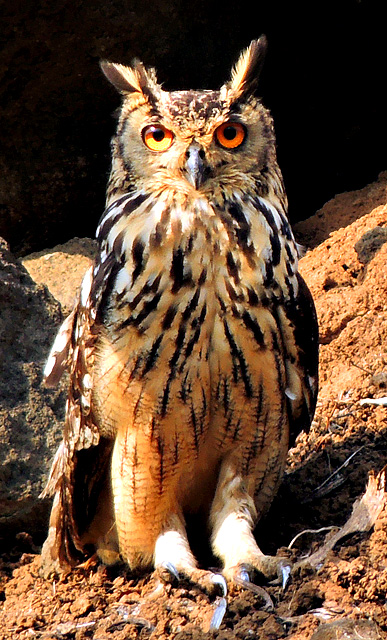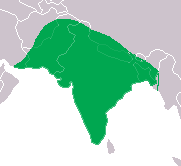Post by OldGreenVulture on Sept 27, 2019 12:24:43 GMT
Bengal Eagle-owl - Bubo bengalensis.

Scientific classification
Kingdom: Animalia
Phylum: Chordata
Class: Aves
Order: Strigiformes
Family: Strigidae
Genus: Bubo
Species: B. bengalensis
Description: This species is often considered a subspecies of the Eurasian Eagle-owl Bubo bubo and is very similar in appearance. The facial disk is unmarked and has a black border, a feature that is much weaker in the Eurasian form. The base of the primaries is unbanded and rufous. The tail bands have the tawn bands wider than the black ones. A large pale scapular patch is visible on the folded wing.The inner claws are the longest. The last joint of the toes are unfeathered.
The taxonomy of the group is complex due to a large amount of variation. Dementiev was the first to consider the possibility of bengalensis being distinct within the Bubo bubo group. However Charles Vaurie noted that this as well as ascalaphus appeared to be distinct and not part of clinal variation. There is a lot of colour variation with the ground colour being dark brown above while some are pale and yellowish. On dark birds the streaks coalesce on the hind crown and nape but are narrow in pale birds. However, Vaurie notes that despite the variation, they are distinct from neighbouring forms B. b. tibetanus, B. b. hemachalana and B. b. nikolskii, in being smaller and richly coloured. Stuart Baker noted that there were two plumage variants that were seen across their range, one plumage has the back and scapulars spotted in white while the other form has a reduced number of white spots on the feathers of the back and the dark streaking on the back, neck and scapulars being prominent.
Chicks are born with white fluff which is gradually replaced by speckled feathers during the prejuvenile moult after about two weeks. After a month or so they go through a prebasic moult and a brownish juvenile plumage is assume with the upperparts somewhat like in adults but the underside is downy. The full adult plumage is assumed much later.

Distribution and habitat: They are seen in scrub and light to medium forests but are especially seen near rocky places within the mainland of the Indian Subcontinent south of the Himalayas and below 1,500 metres (5,000 ft) elevation. Humid evergreen forest and extremely arid areas are avoided. Bush covered rocky hillocks and ravines, and steep banks of rivers and streams are favourite haunts. It spends the day under the shelter of a bush or rocky projection, or in a large mango or similar thickly foliaged tree near villages.

Diet: Their diet through much of the year consists of rodents, but birds seem to be mainly taken towards winter. Prey species of birds include partridges, doves, Indian roller, the shikra and the spotted owlet. Birds the size of a peacock are sometimes attacked. Rodents noted in a study in Pondicherry were Tatera indica, Golunda ellioti, Rattus sp., Mus booduga and Bandicota bengalensis. Bats were also preyed on. In Pakistan, Nesokia indica is an important prey item in their diet. Mammals the size of a Black-naped hare Lepus nigricollis may be taken. In Pakistan, they have been found to take Lepus capensis and Eupetaurus cinereus.
When feeding on rodents, they tear up the prey rather than swallow them whole. Captives feed on about 61g of prey per day.
Other data: The deep resonant two note calls are characteristic and males deliver these "long calls" mainly at dusk during the breeding season. The peak calling intensity is noticed in February. Young birds produce clicks, hisses and open up their wings to appear larger than they are. Nesting adults will fly in zig zag patterns and mob any potential predators (including humans) who approach the nest.
The nesting season is November to April. The eggs number three to four and are creamy white, broad roundish ovals with a smooth texture. They are laid on bare soil in a natural recess in an earth bank, on the ledge of a cliff, or under the shelter of a bush on level ground. The nest site is reused each year. The eggs hatch after about 33 days and the chicks are dependent on their parents for nearly six months.

From Carnivora.
carnivora.net/bengal-eagle-owl-bubo-bengalensis-t6085.html#p54944

Scientific classification
Kingdom: Animalia
Phylum: Chordata
Class: Aves
Order: Strigiformes
Family: Strigidae
Genus: Bubo
Species: B. bengalensis
Description: This species is often considered a subspecies of the Eurasian Eagle-owl Bubo bubo and is very similar in appearance. The facial disk is unmarked and has a black border, a feature that is much weaker in the Eurasian form. The base of the primaries is unbanded and rufous. The tail bands have the tawn bands wider than the black ones. A large pale scapular patch is visible on the folded wing.The inner claws are the longest. The last joint of the toes are unfeathered.
The taxonomy of the group is complex due to a large amount of variation. Dementiev was the first to consider the possibility of bengalensis being distinct within the Bubo bubo group. However Charles Vaurie noted that this as well as ascalaphus appeared to be distinct and not part of clinal variation. There is a lot of colour variation with the ground colour being dark brown above while some are pale and yellowish. On dark birds the streaks coalesce on the hind crown and nape but are narrow in pale birds. However, Vaurie notes that despite the variation, they are distinct from neighbouring forms B. b. tibetanus, B. b. hemachalana and B. b. nikolskii, in being smaller and richly coloured. Stuart Baker noted that there were two plumage variants that were seen across their range, one plumage has the back and scapulars spotted in white while the other form has a reduced number of white spots on the feathers of the back and the dark streaking on the back, neck and scapulars being prominent.
Chicks are born with white fluff which is gradually replaced by speckled feathers during the prejuvenile moult after about two weeks. After a month or so they go through a prebasic moult and a brownish juvenile plumage is assume with the upperparts somewhat like in adults but the underside is downy. The full adult plumage is assumed much later.

Distribution and habitat: They are seen in scrub and light to medium forests but are especially seen near rocky places within the mainland of the Indian Subcontinent south of the Himalayas and below 1,500 metres (5,000 ft) elevation. Humid evergreen forest and extremely arid areas are avoided. Bush covered rocky hillocks and ravines, and steep banks of rivers and streams are favourite haunts. It spends the day under the shelter of a bush or rocky projection, or in a large mango or similar thickly foliaged tree near villages.

Diet: Their diet through much of the year consists of rodents, but birds seem to be mainly taken towards winter. Prey species of birds include partridges, doves, Indian roller, the shikra and the spotted owlet. Birds the size of a peacock are sometimes attacked. Rodents noted in a study in Pondicherry were Tatera indica, Golunda ellioti, Rattus sp., Mus booduga and Bandicota bengalensis. Bats were also preyed on. In Pakistan, Nesokia indica is an important prey item in their diet. Mammals the size of a Black-naped hare Lepus nigricollis may be taken. In Pakistan, they have been found to take Lepus capensis and Eupetaurus cinereus.
When feeding on rodents, they tear up the prey rather than swallow them whole. Captives feed on about 61g of prey per day.
Other data: The deep resonant two note calls are characteristic and males deliver these "long calls" mainly at dusk during the breeding season. The peak calling intensity is noticed in February. Young birds produce clicks, hisses and open up their wings to appear larger than they are. Nesting adults will fly in zig zag patterns and mob any potential predators (including humans) who approach the nest.
The nesting season is November to April. The eggs number three to four and are creamy white, broad roundish ovals with a smooth texture. They are laid on bare soil in a natural recess in an earth bank, on the ledge of a cliff, or under the shelter of a bush on level ground. The nest site is reused each year. The eggs hatch after about 33 days and the chicks are dependent on their parents for nearly six months.

From Carnivora.
carnivora.net/bengal-eagle-owl-bubo-bengalensis-t6085.html#p54944

